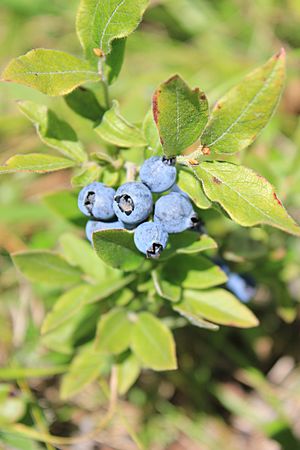Vaccinium myrtilloides facts for kids
Quick facts for kids Vaccinium myrtilloides |
|
|---|---|
 |
|
| Conservation status | |
| Scientific classification | |
| Kingdom: | |
| (unranked): | |
| (unranked): | |
| (unranked): | |
| Order: | |
| Family: | |
| Genus: | |
| Species: |
V. myrtilloides
|
| Binomial name | |
| Vaccinium myrtilloides Michx. 1803
|
|
| Synonyms | |
|
|
The Vaccinium myrtilloides is a type of shrub often called the common blueberry or Canadian blueberry. You might also hear it called velvetleaf huckleberry or sourtop blueberry. This plant is very common across much of North America. It grows in all 10 Canadian provinces, plus Nunavut and the Northwest Territories. You can also find it in the northeastern and Great Lakes states of the United States, as well as in Montana and Washington.
Contents
What Does the Canadian Blueberry Look Like?
The Vaccinium myrtilloides is a small, spreading deciduous shrub. This means it loses its leaves in the fall. It usually grows up to 50 centimeters (about 20 inches) tall. Often, it spreads out to form small groups of plants called thickets.
Its leaves are bright green on top and lighter underneath. They feel soft because they have velvety hairs. The flowers are white and shaped like tiny bells, about 5 millimeters (0.2 inches) long. The fruit is a small, sweet berry that can be bright blue or dark blue. Young stems on the plant have stiff, bristly hairs.
Where Does This Blueberry Grow Best?
This blueberry plant loves to grow in open conifer forests. It prefers dry, loose, and acidic soils. You can also find it in wooded bogs and rocky areas. This plant is tough and can survive forest fires. It often grows a lot after fires or when areas have been clear-cut. The Vaccinium myrtilloides can even mix with another type of blueberry, Vaccinium angustifolium (lowbush blueberry), in the wild.
Why Is This Blueberry Special?
The Vaccinium myrtilloides is grown for sale in Canada and Maine. Farmers often manage wild patches of these plants to harvest the berries. This type of blueberry is known for being one of the sweetest blueberries you can find!
Who Eats This Blueberry?
These berries are a very important food source for many animals. Black bears, deer, small mammals, and various birds all enjoy eating them.
Is the Canadian Blueberry Protected?
In some parts of the United States, this blueberry needs special protection. It is listed as endangered in Indiana and Connecticut. This means there are very few of these plants left in those states. It is listed as threatened in Iowa and Ohio, meaning it could become endangered soon. In Washington (state), it is considered sensitive.
How Native American People Use Blueberries
Native American communities have used these berries for a very long time. They are an important part of their traditions and daily life.
Blueberries as Food
Many different tribes eat the fruit as part of their traditional meals:
- The Abenaki people eat the berries.
- The Nihithawak Cree eat the berries fresh. They also make them into jam to eat with fish and bannock (a type of bread). They boil or pound sun-dried berries to make pemmican, a traditional food.
- The Hesquiaht First Nation use the berries to make pies and preserves.
- The Hoh and Quileute tribes eat the fruit raw. They also stew the berries to make a sauce. They can the berries to save them for winter.
- The Ojibwa gather and sell the berries. They eat them fresh, dry them in the sun, and can them for later.
- The Nlaka'pamux people make pies from the berries.
- The Algonquin people gather the fruit to eat and sell.
- The berries are part of Potawatomi traditional cooking. They are eaten fresh, dried, and canned.
Other Uses for Blueberries
Besides food, the Nihithawak Cree also use the berries for other purposes. They use the juice from the berries to dye porcupine quills, giving them a beautiful color.


